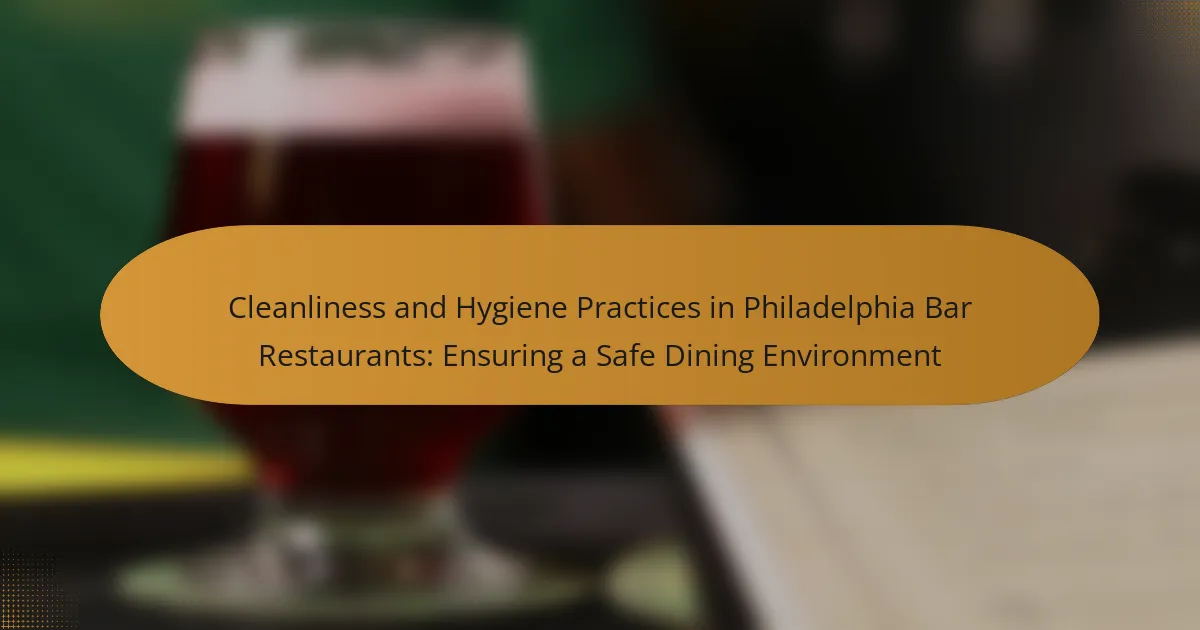
What are Cleanliness and Hygiene Practices in Philadelphia Bar Restaurants?
Cleanliness and hygiene practices in Philadelphia bar restaurants include regular sanitation of surfaces, proper food handling, and employee health protocols. Bar restaurants must adhere to the Philadelphia Department of Public Health regulations. These regulations mandate frequent cleaning of tables, utensils, and restrooms. Additionally, staff are trained in safe food preparation techniques. Handwashing stations are required and must be accessible to employees. The use of gloves during food handling is also enforced. Regular inspections by health officials ensure compliance with these standards. Such practices help prevent foodborne illnesses and maintain a safe dining environment.
Why are cleanliness and hygiene essential in bar restaurants?
Cleanliness and hygiene are essential in bar restaurants to prevent foodborne illnesses. Maintaining high standards of cleanliness reduces the risk of contamination. Regular cleaning of surfaces and utensils is crucial. According to the CDC, foodborne diseases affect 48 million Americans annually. Proper hygiene practices ensure customer safety and satisfaction. Clean environments also enhance the establishment’s reputation. Customers are more likely to return to a clean bar restaurant. Health inspections often focus on cleanliness, impacting business operations.
What health risks are associated with poor hygiene in dining establishments?
Poor hygiene in dining establishments can lead to significant health risks. These risks include foodborne illnesses, such as salmonella and E. coli infections. Contaminated surfaces and improper food handling contribute to these diseases. According to the Centers for Disease Control and Prevention (CDC), approximately 48 million people in the U.S. get sick from foodborne illnesses each year. Additionally, poor hygiene can result in cross-contamination, where pathogens spread from one food item to another. This increases the likelihood of outbreaks. Another risk is the presence of pests, which can carry diseases and contaminate food. Regular inspections and strict adherence to hygiene standards are vital for minimizing these risks.
How do cleanliness practices impact customer satisfaction?
Cleanliness practices significantly enhance customer satisfaction. Customers often associate cleanliness with quality and safety in dining establishments. A study by the Journal of Environmental Health found that 70% of patrons consider cleanliness a top priority when choosing a restaurant. Additionally, clean environments lead to positive dining experiences, fostering repeat business. Poor hygiene can result in negative reviews and loss of customers. Maintaining high cleanliness standards is essential for sustaining a positive reputation.
What regulations govern cleanliness and hygiene in Philadelphia bar restaurants?
Philadelphia bar restaurants are governed by the Philadelphia Department of Public Health regulations. These regulations mandate standards for cleanliness and hygiene. They include proper food handling procedures, employee health requirements, and sanitation practices. The regulations also require regular inspections to ensure compliance. Violations can lead to fines or closure. Specific guidelines are outlined in the Philadelphia Food Code. This code aligns with state and federal food safety standards. Regular training for staff is also mandated to maintain hygiene practices.
Which agencies oversee hygiene standards in the food industry?
The agencies that oversee hygiene standards in the food industry include the Food and Drug Administration (FDA) and the United States Department of Agriculture (USDA). The FDA sets regulations for food safety and hygiene practices. The USDA focuses on the safety of meat, poultry, and egg products. Local health departments also play a crucial role in enforcing hygiene standards at the community level. They conduct inspections and ensure compliance with state and local regulations. These agencies work together to protect public health and ensure safe food handling practices. Their combined efforts help prevent foodborne illnesses and promote hygiene in the food industry.
What are the key regulations that bar restaurants must comply with?
Bar restaurants must comply with health and safety regulations, food handling standards, and alcohol licensing laws. These regulations ensure cleanliness and hygiene in food preparation and service. The Philadelphia Department of Public Health mandates regular health inspections. These inspections assess food safety practices, sanitation, and employee hygiene. Bar restaurants must also adhere to the Pennsylvania Liquor Control Board’s regulations for serving alcohol. Compliance with these laws prevents health hazards and legal issues. Failure to comply can result in fines or closure.
What are the common cleanliness practices implemented in bar restaurants?
Bar restaurants implement several common cleanliness practices to maintain a safe dining environment. Regular cleaning of surfaces is essential. This includes wiping down tables, bar tops, and menus after each use. Staff frequently sanitize high-touch areas, such as door handles and light switches. Dishware and glassware undergo thorough washing and sanitization between uses. Restrooms receive consistent cleaning and restocking of supplies. Staff members follow personal hygiene protocols, including handwashing before handling food. Food storage areas are kept organized and at proper temperatures. Regular pest control measures are also in place to prevent infestations. These practices collectively ensure a hygienic atmosphere for patrons.
How often should bar restaurants conduct cleaning and sanitization?
Bar restaurants should conduct cleaning and sanitization daily. High-touch areas like tables, menus, and door handles require cleaning after each use. Restrooms should be sanitized multiple times throughout the day. Additionally, deep cleaning should occur weekly to maintain overall hygiene standards. The CDC recommends these practices to reduce the spread of pathogens. Regular cleaning helps ensure a safe dining environment for customers and staff.
What areas of the restaurant require the most attention for cleanliness?
The areas of the restaurant that require the most attention for cleanliness include the kitchen, restrooms, dining area, and food storage areas. The kitchen is critical as it is where food is prepared. A clean kitchen prevents cross-contamination and foodborne illnesses. Restrooms must be sanitized regularly to ensure customer hygiene. The dining area should be cleaned frequently to maintain a pleasant atmosphere. Food storage areas need to be organized and free of pests. Regular inspections and adherence to health regulations are essential for maintaining cleanliness in these areas.
How do bar restaurants train staff on hygiene practices?
Bar restaurants train staff on hygiene practices through structured training programs. These programs typically include workshops on proper handwashing techniques. Staff learn about food safety standards and regulations. Training often covers cross-contamination prevention methods. Many establishments use visual aids to reinforce learning. Regular assessments ensure staff retention of hygiene practices. Onboarding processes include hygiene training for new hires. Continuous education is provided to keep staff updated on best practices.
What topics are covered in hygiene training for restaurant staff?
Hygiene training for restaurant staff covers several key topics. These include food safety practices, personal hygiene standards, and proper handwashing techniques. Staff learn about cross-contamination prevention and safe food storage methods. Training also emphasizes the importance of cleaning and sanitizing surfaces and equipment. Additionally, staff are educated on pest control measures and reporting foodborne illnesses. Understanding the significance of temperature control for food safety is another crucial topic. These elements are essential for maintaining a safe dining environment. Proper hygiene training reduces the risk of foodborne illnesses and ensures compliance with health regulations.
How is the effectiveness of hygiene training evaluated?
The effectiveness of hygiene training is evaluated through assessments, observations, and feedback. Evaluators often use pre- and post-training assessments to measure knowledge retention. Observations of employees in their work environment provide insights into practical application. Feedback from both trainers and participants helps identify areas for improvement. Compliance rates with hygiene standards can also indicate training effectiveness. Regular audits and inspections further validate the impact of the training. Research indicates that consistent evaluation leads to enhanced hygiene practices in food service settings.
What challenges do bar restaurants face in maintaining cleanliness and hygiene?
Bar restaurants face several challenges in maintaining cleanliness and hygiene. High customer volume can lead to rapid accumulation of dirt and grime. Limited staff during peak hours makes thorough cleaning difficult. The presence of food and drink spills increases the risk of contamination. Equipment and surfaces require constant sanitization to prevent foodborne illnesses. Compliance with health regulations can be complex and time-consuming. Additionally, staff training on hygiene practices is essential but often inconsistent. These factors contribute to the ongoing struggle for bar restaurants to uphold cleanliness and hygiene standards.
How do staffing issues affect hygiene practices?
Staffing issues negatively impact hygiene practices in bar restaurants. Insufficient staff can lead to inadequate cleaning and sanitation. When employees are overworked, they may overlook essential hygiene tasks. A study by the National Restaurant Association found that 75% of foodborne illness outbreaks are linked to improper hygiene practices. High turnover rates disrupt training on hygiene standards. Inexperienced staff may not follow protocols correctly. Lack of staff also limits the ability to maintain frequent cleaning schedules. Overall, staffing challenges directly correlate with compromised hygiene standards in dining environments.
What are the common misconceptions about cleanliness in the food industry?
Common misconceptions about cleanliness in the food industry include the belief that a clean appearance guarantees food safety. Many assume that visible cleanliness, such as spotless floors and shiny utensils, means that food is safe to eat. However, foodborne pathogens can still thrive in seemingly clean environments. Another misconception is that high temperatures alone ensure cleanliness. While cooking at high temperatures kills most bacteria, it does not address cross-contamination or improper handling.
Additionally, some people think that frequent cleaning is unnecessary once a restaurant passes health inspections. In reality, ongoing cleanliness is essential to maintain safety standards. There is also a belief that organic or natural foods are inherently cleaner than conventional foods. This is not always true, as both types can harbor harmful bacteria if not handled properly.
Lastly, many believe that all food handlers are adequately trained in hygiene practices. Unfortunately, not all establishments prioritize comprehensive training, leading to potential lapses in cleanliness. These misconceptions can pose risks to public health and highlight the importance of continuous education and vigilance in the food industry.
How can bar restaurants improve their cleanliness and hygiene practices?
Bar restaurants can improve their cleanliness and hygiene practices by implementing strict sanitation protocols. Regular cleaning schedules should be established for all surfaces, including tables, chairs, and bar counters. Staff training on proper hygiene practices is essential. This includes handwashing techniques and safe food handling procedures.
Using disinfectants approved by health authorities can enhance cleanliness. Regular inspections can ensure compliance with hygiene standards. Encouraging customer feedback on cleanliness can provide insights for improvement. Adopting a zero-tolerance policy for cleanliness violations reinforces the importance of hygiene. These practices contribute to a safer dining environment and can increase customer trust.
What innovative solutions are available for enhancing hygiene in restaurants?
Innovative solutions for enhancing hygiene in restaurants include touchless technology, UV-C sanitation, and antimicrobial surfaces. Touchless technology minimizes contact points, reducing germ transmission. For instance, touchless faucets and soap dispensers are increasingly adopted. UV-C sanitation systems effectively kill bacteria and viruses on surfaces and in the air. Many restaurants now use UV-C light for cleaning equipment and dining areas. Antimicrobial surfaces, made from materials that inhibit microbial growth, are being integrated into restaurant design. These surfaces can significantly lower the risk of contamination. Additionally, digital menus and ordering systems reduce physical contact. These innovations collectively enhance hygiene and promote a safer dining experience.
How can technology assist in maintaining cleanliness standards?
Technology assists in maintaining cleanliness standards through automation, monitoring, and data analysis. Automated cleaning devices, such as robotic vacuums and floor scrubbers, reduce human error. These devices can operate on a schedule, ensuring consistent cleaning. Monitoring systems, like IoT sensors, track cleanliness levels in real-time. They can alert staff to areas needing immediate attention. Data analysis tools provide insights into cleaning patterns and effectiveness. This allows for optimized cleaning schedules and resource allocation. A study by the American Cleaning Institute shows that technological integration can improve hygiene compliance by up to 30%.
What best practices can bar restaurants adopt for a safe dining environment?
Bar restaurants can adopt several best practices to ensure a safe dining environment. First, they should implement rigorous cleaning protocols. This includes sanitizing surfaces frequently, especially high-touch areas like menus and tables. Second, staff should be trained on proper hygiene practices. This training should cover handwashing techniques and the use of personal protective equipment.
Third, bar restaurants should ensure proper ventilation in dining areas. Good air circulation helps reduce the risk of airborne pathogens. Fourth, they should establish a clear policy for sick employees. Staff showing symptoms should be encouraged to stay home to prevent spreading illness.
Fifth, bar restaurants can limit capacity to allow for social distancing. This practice helps maintain a safe distance between patrons. Lastly, they should communicate safety measures to customers. Clear signage about hygiene practices builds trust and reassures diners about their safety.
How can customers contribute to maintaining hygiene in bar restaurants?
Customers can contribute to maintaining hygiene in bar restaurants by practicing good personal hygiene and following restaurant guidelines. Washing hands before eating is essential to reduce the spread of germs. Using hand sanitizer when soap and water are unavailable also helps. Customers should avoid touching their faces while dining. Properly disposing of napkins and food waste in designated bins prevents contamination. Following any posted health and safety protocols promotes a cleaner environment. Additionally, reporting any cleanliness issues to staff can help address problems promptly. These actions collectively support the overall hygiene efforts of the establishment.
The main entity of this article is cleanliness and hygiene practices in Philadelphia bar restaurants, which are critical for ensuring a safe dining environment. The article outlines the essential regulations mandated by the Philadelphia Department of Public Health, highlighting the importance of regular sanitation, proper food handling, and employee health protocols. It discusses the health risks associated with poor hygiene, the impact of cleanliness on customer satisfaction, and common practices implemented by bar restaurants to maintain hygiene standards. Additionally, the article addresses the challenges faced by these establishments in upholding cleanliness and explores innovative solutions and best practices for enhancing hygiene.




